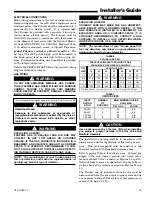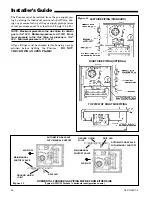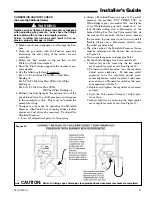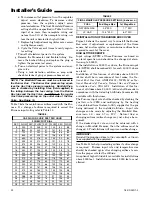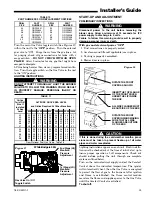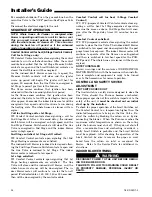
12
18-CD24D1-2
Installer’s Guide
VENT PIPING
These Furnaces have been classified as Fan-Assisted
Combustion System, Category I Furnaces under the
“latest edition” provisions of ANSI Z21.47 and CAN/
CGA 2.3 standards. Category I Furnaces operate with a
non-positive vent static pressure and with a flue loss of
not less than 17 percent.
NOTE: If desired, a side wall termination can be accom-
plished through the use of an “add-on” draft inducer.
The inducer must be installed according to the inducer
manufacturer’s instructions. Set the barometric pres-
sure relief to achieve -0.02 inch water column.
NOTE: The Furnace shall be connected to a chimney or
vent complying with a recognized standard, or a ma-
sonry or concrete chimney lined with a lining material
acceptable to the authority having jurisdiction.
▲
WARNING
!
Furnace venting into an unlined masonry chimney or
concrete chimney is prohibited.
Failure to follow this warning could result in property
damage, personal injury, or death.
VENTING INTO A MASONRY CHIMNEY
If the chimney is oversized, the liner is inadequate, or
flue-gas condensation is a problem in your area, con-
sider using the chimney as a pathway or chase for type
“B” vent or flexible vent liner. If flexible liner material
is used, size the vent using the “B” vent tables, then re-
duce the maximum capacity by 20% (multiply 0.80
times the maximum capacity). Masonry Chimney Kit
BAYVENT800B may be used with these Furnaces
(Upflow model furnaces only)
to allow venting into a
masonry chimney. Refer to the BAYVENT800B
Installer’s Guide for application requirements.
Internal Masonry Chimneys
Venting of fan assisted appliances into a lined, internal
masonry chimney is allowed only if it is common vented
with at least one natural draft appliance;
OR
, if the
chimney is lined with type “B”, double wall vent or suit-
able flexible liner material (See Table 4).
▲
WARNING
!
The chimney liner must be thoroughly inspected to in-
sure no cracks or other potential areas for flue gas
leaks are present in the liner. Liner leaks will result in
early deterioration of the chimney.
Failure to follow this warning could result in carbon
monoxide poisoning or death.
NOTE: The following section does not apply if
BAYVENT800B (Masonry Chimney Vent Kit) is used. All
instructions with the kit must be followed.
GENERAL VENTING INSTRUCTIONS
CARBON MONOXIDE POISONING HAZARD
Failure to follow the steps outlined below for each
appliance connected to the venting system being
placed into operation could result in carbon
monoxide poisoning or death.
The following steps shall be followed for each appliance
connected to the venting system being placed into
operation, while all other appliances connected to the
venting system are not in operation:
1. Seal any unused openings in the venting system.
2. Inspect the venting system for proper size and
horizontal pitch, as required in the National Fuel
Gas Code, ANSI Z223.1/NFPA 54 or the CSA
B149.1
Natural Gas and Propane Installation Code
and these instructions. Determine that there is no
blockage or restriction, leakage, corrosion and other
deficiencies which could cause an unsafe condition.
3. As far as practical, close all building doors and
windows and all doors between the space in which
the appliance(s) connected to the venting system
are located and other deficiencies which could
cause an unsafe condition.
4. Close fireplace dampers.
5. Turn on clothes dryers and any appliance not
connected to the venting system. Turn on any
exhaust fans, such as range hoods and bathroom
exhausts, so they are operating at maximum speed.
Do not operate a summer exhaust fan.
6. Follow the lighting instructions. Place the appliance
being inspected into operation. Adjust the
thermostat so appliance is operating continuously.
7. Test for spillage from draft hood equipped appliances
at the draft hood relief opening after 5 minutes of
main burner operation. Use the flame of a match or
candle.
8. If improper venting is observed during any of the
above tests, the venting system must be corrected
in accordance with the National Fuel Gas Code,
ANSI Z221.1/NFPA 54 and/or CSA B149.1
Natural
Gas and Propane Installation Code
.
9. After it has been determined that each appliance
connected to the venting system properly vents
where
tested as outlined above, return doors,
windows, exhaust fans, fireplace dampers and any
other gas
-fired burning appliance to their previous
conditions of use.
▲
WARNING
!



















